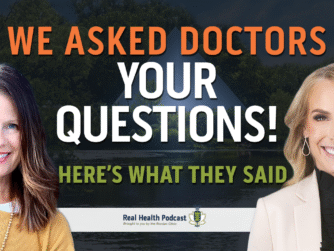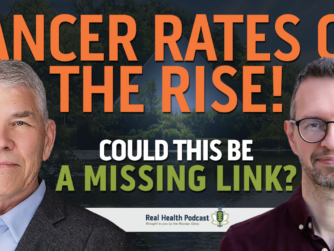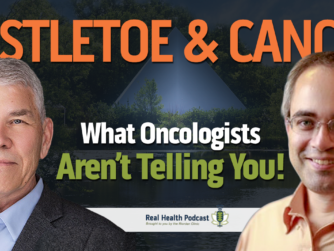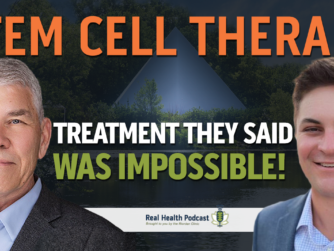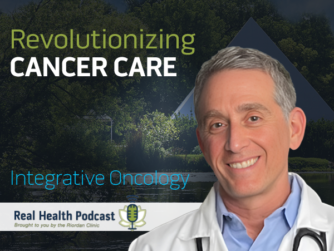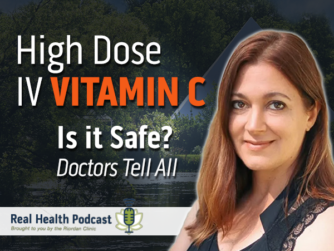In this episode, Mike Shaw and Dr. Ron discuss anti-aging and the community that started the anti-aging movement. Do you know your physiological age? Mike and Dr. Ron distinguish the difference between one’s chronological age and physiological age. Mike discusses what steps you can take to measure and match your PhysioAge to your actual age.
Thank You To This Episode’s Sponsor
Episode Transcript
Disclaimer: The information contained on The Real Health podcast and the resources mentioned are for educational purposes only. They are not intended as and shall not be understood or construed as medical or health advice. The information contained on this podcast is not a substitute for medical or health advice from a professional who is aware of the facts and circumstances of your individual situation. Information provided by hosts and guests on The Real Health podcast or the use of any products or services mentioned does not create a practitioner patient relationship between you and any person’s affiliated with this podcast.
Intro: This is The Real Health podcast brought to you by Riordan Clinic. Our mission is to bring you the latest information and top experts in functional and integrative medicine to help you make informed decisions on your path to real health..
Dr. Ron Hunninghake: Well, hello everyone, it’s Dr. Ron Hunninghake, and we’re back with another Real Health Podcast. And it’s my pleasure to welcome back Mike Shaw. Mike, how are you doing?
Mike Shaw: I’m doing great and I’m sure pleased to be here.
Dr. Ron Hunninghake: Oh, great to have you. And you all might remember that we covered vascular health the last time with Mike and today we’re going to talk about anti-aging medicine and you have such an interesting story. What happened in 1994 that kind of set the stage?
Mike Shaw: Actually, I had just joined Galichia Medical Group in cardiology in 1994, and I had a magazine and read an article about eight physicians that had convened in Las Vegas and formed this academy called the Academy of Anti-Aging Medicine, the A4M.
Dr. Ron Hunninghake: Yeah and then you became a regular then after that.
Mike Shaw: I went to the first conference in 1995 and I’ve been to every conference since that year.
Dr. Ron Hunninghake: Wow, how many conferences is that?
Mike Shaw: Once a year.
Dr. Ron Hunninghake: About 30 some conferences?
Mike Shaw: Yes.
Dr. Ron Hunninghake: Okay, so you obviously had a tremendous interest then in anti-aging medicine. My understanding is that they make a big distinction between chronological versus physiological aging. Kind of tell us a little bit, what is that distinction?
Mike Shaw: Well, and I think even in cardiology and in pulmonary medicine prior to that, I think people sometimes have a confused… They think in terms of chronological time, but, and that a year older means that you’re a year older, but in chronological time, but that doesn’t necessarily have to equate to physiologic time. And that was one of the things that really got me interested in starting delving deeper into the physiology and ways to test or analyze what are you physiologically in relation to your chronological time?
Dr. Ron Hunninghake: The way I relate to that is if people undergo some very stressful event, even though a year has passed, they may look like three to five years have passed because they actually aged faster than a year physiologically, that’s what you’re talking about?
Mike Shaw: That’s exactly correct.
Dr. Ron Hunninghake: Okay so, and all these terms are really interesting terms and I’m sure people would say, “Well, that’s very interesting,” but how can we make a change? How could we… And even if we did make a change, how would we know we had actually slowed down physiological aging? Is there some instrument or some measurement that we can use to do that?
Mike Shaw: Well, after I joined this American Academy of Anti-Aging Medicine, about the fourth or fifth year of the conferences, I met a physician named Dr. Joseph Raffaele. He has a group in New York and he developed an advanced evaluation platform called PhysioAge. And the PhysioAge program includes not only an extensive physical examination, but diagnostic equipment capable of evaluating the physiological age of each of several major organ systems of the body and letting us quantify, “Well, you might be 50 years old, but your vascular age is 65.”
Dr. Ron Hunninghake: Yeah, so just to let everyone know, I went through this… What was that about, three years ago?
Mike Shaw: Yes.
Dr. Ron Hunninghake: And then, two years later I did a repeat of this and one of my markers, which I was a little bit surprised on was the stiffness of my arteries, they had gotten a little bit stiffer. So, how does that represent physiologic aging?
Mike Shaw: Well, because depending on a lot of variables inside the body, but things like loss of essential nutrients are pro-inflammatory states that tend to affect the vascular wall and calcification. I mean, there’s lots of things can start occurring that stiffen the arterial wall and it loses its suppleness. And you can end up with problems with limited blood flow, increased blood pressure, poor perfusion.
Dr. Ron Hunninghake: And so one of the action steps was to use nitric oxide lozenges as a way of dilating and opening up the blood vessels, being more careful about my omega fatty acids, and so that piece of information was crucial for me to take a definitive step towards bringing that particular measurement under better control.
Mike Shaw: And I think one of the other big perspectives, and I think a lot of the patients that come out to Riordan Clinic appreciate it, you didn’t hear anything about a prescriptive drug in what you just said. Nitric oxide is something that the body manufactures in rather large amounts when you’re young and youthful and it tends to decline with aging, usually men in their 30s and women in their 40s. So restore nitric oxide, restore dilation, perfusion, blood flow.
Dr. Ron Hunninghake: As a result of that, I also looked into the whole sleep issue and found out that I was a mouth breather. And so as a result, I started using a special little piece of equipment to keep my mouth closed during sleep and my sleep improved. And my understanding is if you’re a better nose breather, you’ll make nitric oxide better. And so that’s a way of improving nitric oxide without even taking anything. That new to you?
Mike Shaw: I haven’t heard… Yeah, that’s new to me, that’s good.
Dr. Ron Hunninghake: Yeah, so anyway, so how many measurements do you do in the typical PhysioAge?
Mike Shaw: Okay, so the PhysioAge platform, it’s based on… Originally, there were six biomarkers of aging and they’ve added two more, but one’s a part of the regular program, the other one is an add-on that costs more to do. So the six are that looking at cardiovascular age, looking at lung age, looking at skin age, looking at neurocognitive age, looking at immune system, and then DNA, or we call it… They call it DNA now, but it’s actually looking at the DNA and the strand on the end of the DNA called telomere and the rate at which it is shortening which determines the life of that cell. And then it either dies or goes into senescence. So it looks at those six and the other one is they just added is pheno-age, so it takes a blood sample and it analyzes all of the blood components and equates that to its own organ system, the blood, what the age of that system is.
Dr. Ron Hunninghake: Would that be related to immunity?
Mike Shaw: It can, because it will look at immune cells plus white cells, red cells.
Dr. Ron Hunninghake: So-
Mike Shaw: Hemoglobin concentration and-
Dr. Ron Hunninghake: Right, so this is not just one marker, this is these six or seven categories, and maybe what, 20, 25, how many markers are there that you’re looking at in PhysioAge, you think?
Mike Shaw: Well, we look at those seven systems, but then there is a vast array of other tests. We look at body composition, we look at fitness functionality by doing treadmill tests and gas exchange to see what your… The fancy term is called VO2 max, but it’s your ability to do physical exertion at a certain level. And of course the higher level you can go, that equates to being in better shape.
Advertisement: There’s a lot more to this conversation and it’s coming up right after a quick break. Today’s episode of the Real Health Podcast is brought to you by the Riordan Clinic Nutrient Store. The Nutrient Store is your resource for the highest quality nutritional supplements. Every supplement in the store is handpicked by the expert medical staff at Riordan Clinic, providing you with the best quality, purity, consistency, and effective dosing available. Visit store.riordanclinic.org to shop online.
Dr. Ron Hunninghake: Yeah, so this all really fits very nicely into the Riordan Clinic approach as was originally designed by Dr. Riordan. He basically said that if you can’t measure something, you can’t manage it. And so when people say, “I’d like to be younger, I’d like to feel better,” if you don’t have some kind of a preliminary measurement, you wouldn’t know where to start or what would be your priority.
Mike Shaw: That’s true, and one of the things that was always attractive about Riordan Clinic was their advanced laboratory analysis of many nutrients and coenzymes and hormones and all this other vast array. And all of that, most of it, goes into PhysioAge and the PhysioAge system gives an A to an F, kind of like a report card, scale rating on where your value fell.
Dr. Ron Hunninghake: Yeah, and really when we look at what’s going on in the last 20, 25 years, the rate of complex chronic illness development in the Western world has gone way up. People are getting sick with early diabetes, pre-diabetes and diabetes, they’re putting on weight that they can’t seem to get rid of, their metabolism is slowing down, they’re having more trouble with sleep and sleep disorders, inflammatory conditions, autoimmune conditions, digestive. So all of that together suggests that somewhere in the body, we’re losing the ability to self-regulate. And so we have to have some means of testing these different systems, if we’re going to detect where the problems are.
Mike Shaw: That’s exactly right and-
Dr. Ron Hunninghake: And so this together kind of does that.
Mike Shaw: Yes and I’ve been a big supporter of supplementation for a lot of years, because clear back when I was in my 20s and a part of the American College of Sports Medicine, I mean nutrition and nutrients are extremely important, not only when you’re young, but even more so when the time clock moves forward and being able to evaluate how you rate on many of those nutrient levels and then know what to target in on to either support or supplement more of, I think is extremely valuable.
Dr. Ron Hunninghake: Yeah, and I know even with Dr Riordan, he was treat-the-whole-person type of guy. And so looking at stress, looking at job satisfaction, looking at basically inflammation in your body, toxicity exposure, sleep, sleep quality, all these things enter into the picture. And we recommend people to shoot for their best choices that they can make. But oftentimes motivation is a problem. And I’ve found that information is many times the very best motivator to get people to you get on the right track.
Mike Shaw: I agree and I think that’s what an examination like this shouldn’t be thought of as a scary, formidable thing to undergo, it’s a broadening of your horizon basically on just where am I at on the physiological timeframe.
Dr. Ron Hunninghake: Right, and a person who’s motivated to do this kind of testing, they’re already interested in slowing the aging process. They’re interested in having more energy, feeling better, getting better quality sleep, reducing their risk for infectious disease, helping them to lose weight and overall feel better. But without a plan, it’s great to say, “Yeah, this is what I want,” but you’ve got to build the structure underneath it. But first you need a blueprint, I see this as a kind of blueprint for better health.
Mike Shaw: For sure, because if you look at those seven biomarkers, each one of those organ systems are functioning the way they are for reasons and many times it’s for the lack of certain hormone or certain nutrients or certain coenzymes that help the cells that make up those tissues that represent that organ system to function in a healthy manner. So I think the two dovetail, one is what’s the aging of my major systems. And then secondly, a comprehensive analysis of all of the new nutrients that the body uses to stay healthy and functional. And when you put them both together, I think it’s a win-win situation.
Dr. Ron Hunninghake: Yeah, and this doesn’t replace going to your regular doctor, but conventional acute care medicine is all about, “Okay, what’s your symptom? Here, we’ll do a test. We’ll check you over. We’ll make a diagnosis and here’s your medicine to treat the symptom.” But it doesn’t look at the whole system, the whole system’s biology type approach, because health is not just one facet, it’s kind of the integration, the synchronization. It’s kind of like a symphony, health is a symphony. And if you’ve got one or two instruments that are out of tune that can wreck the music. And so in a sense, this type of testing helps people get tuned up in real simple words.
Mike Shaw: Yeah, and at one time I had created a phrase that talking about that in the conventional medical world, where I spent a whole long time, kind of a reactive response to pathology versus a proactive causation-focused response to, “Well, what’s missing here? What are we lacking? What do we need to enhance or improve so that the pathology doesn’t ever develop?” Instead of just reacting to it and usually it’s in the form of a prescription medicine or something to treat the surface symptom when it would really be nice to know what the underlying issue is. And many times it’s because of deficiencies inside the body that aren’t being met.
Dr. Ron Hunninghake: So as Dr. Riordan said, “We’re looking for root causes.”
Mike Shaw: Root causes.
Dr. Ron Hunninghake: Yeah. So Mike, hey, this is great having you on our podcast again and is this something that people can just make an appointment with you to talk over and see if it is going to fit them?
Mike Shaw: Absolutely, I’d be more than happy to talk with any and everyone, because I like spreading the word and even more getting patients involved because it’s pretty remarkable to see what happens.
Dr. Ron Hunninghake: Yeah, it’s not… I found it was nothing to be scared of, it was actually made me even more enthusiastic, kind of a be your own health detective, find out where things are not quite sinking right. And then you just tune the engine and you get better performance. And that’s what we’re all interested in is feeling well, living well and having the energy to do what you need to do and want to do with enthusiasm. So, Mike, thank you so much for being on the Real Health Podcast and we’ll look forward to the next time we get together.
Mike Shaw: Look forward to it soon.
Outro: Thank you for listening to the Real Health Podcast. If you enjoy this episode, be sure to subscribe and leave us a review. You can also find all of the episodes and show notes over at realhealthpodcast.org. Also be sure to visit riordanclinic.org where you will find hundreds of videos and articles to help you create your own version of real health.


